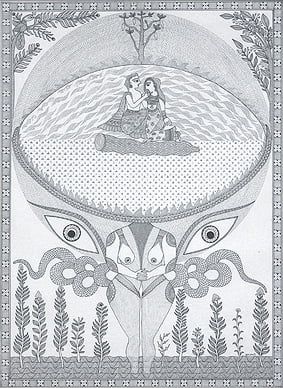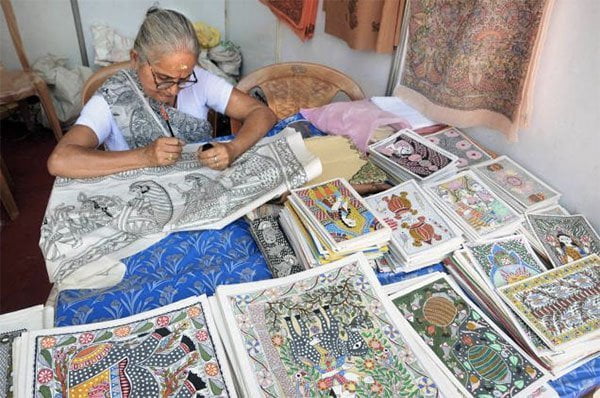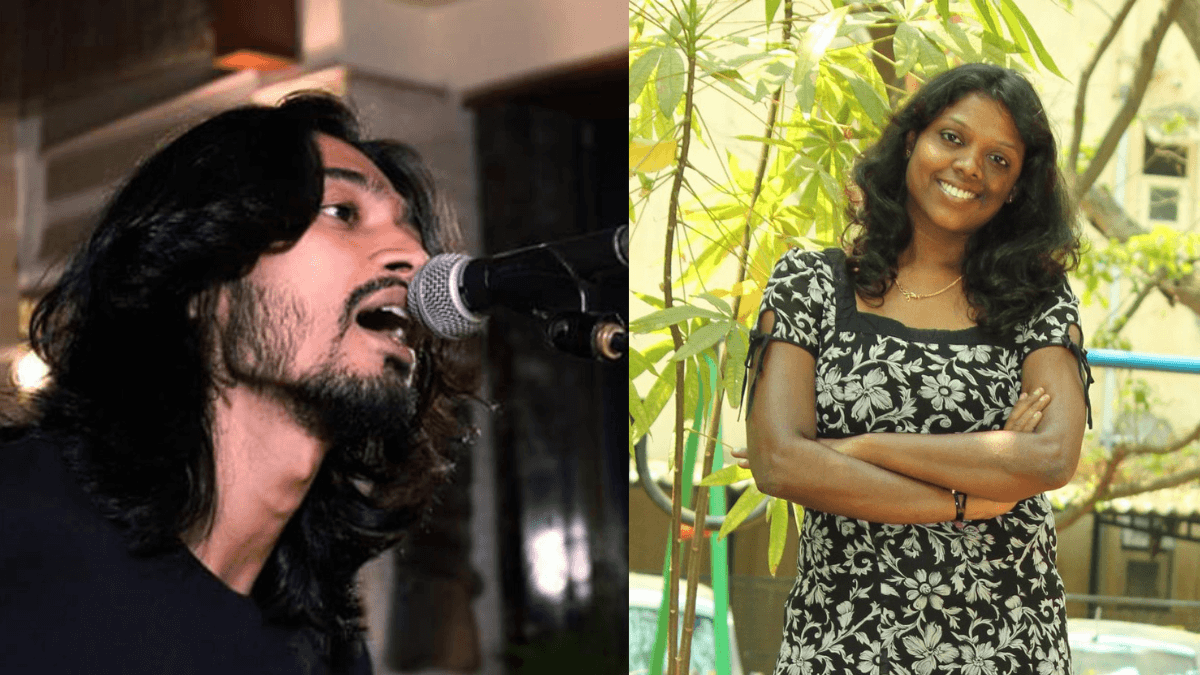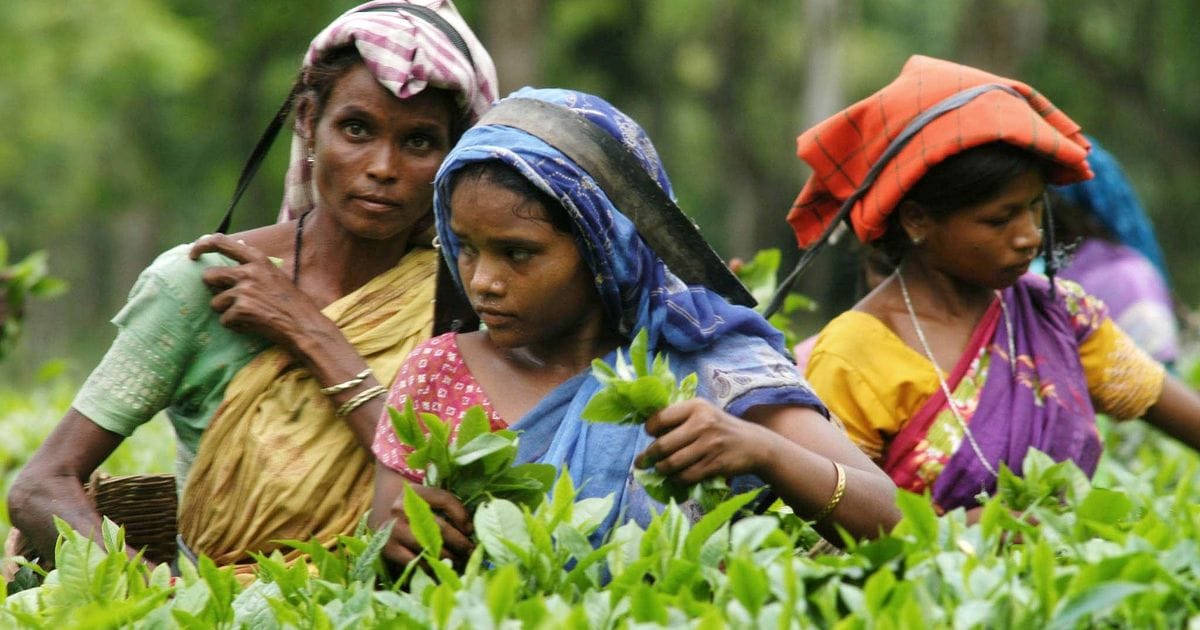Madhubani art reflects the celebration of culture and environment it is practised in. It has now become a popular source of bridging the gap between myth and reality, especially for women. Traditionally used as a way to celebrate birth, marriages and other religious ceremonies, it is now transforming with diverging narratives and being adapted to express the predicament of young women who look forward to a more progressive future, where their rights aren’t curtailed by patriarchal practices.
This growing art form finds its historical roots in the Ramayana, where King Janaka asked an artist to illustrate his daughter Sita’s wedding to Ram. It is mainly practised in the Mithila region in Bihar and Nepal, where women decorate the floor (aripana) and walls (kohabar) for ceremonies. This geometrical art form fills the entire canvas with vibrant colours made of natural vegetable dyes and mineral oxides. It employs tools such as fingers, brushes, twigs, nib pens and matchsticks.
The use of Madhubani has now extended to active political involvement in the empowering of the community by decorating and painting trees to counter the practice of cutting down forests for commercial use. Scholars Armington, Bindloss and Mayhew observed: “Mithila painting is part decoration, part social commentary, recording the lives of rural women in a society where reading and writing are reserved for high-caste men.”
Here’s a list of six Madhubani women artists that we should know about:
1. Sita Devi

Image Credit: Sita Devi Madhubani Painting Blog
Sita Devi was a pioneering Madhubani artist, who exhibited the nature and influence of the arts in the socio-political development of an underdeveloped region in rural India. She brought the bharni form out of homes and showcased it in public, both in India and abroad. Her work was officially recognized by the Government of India in 1981 and she was awarded the Padma Shri.
N.K Jha noted that because of Sita Devi’s commitment and popularity, her village Jitwarpur had its first primary and then secondary school, paved roads with bricks and got electricity poles in the region. She undertook a project of teaching 1000 villagers Madhubani art for social and financial empowerment.
In one of the noted interviews, she stated, “Politicians do nothing… I lived in Pragati Maidan in New Delhi and knew big shots. I always spoke to them about my village and how things could improve here,” she said. Her demands for the development of her village are still warmly remembered in Jitwarpur.
2. Mahasundari Devi

Image Credit: Wikipedia
It was in 1961 when Mahasundari Devi shed her purdah (veil) and picked up the brush to practice Madhubani which further inspired future generations to empower themselves. She was the founder of Mithila Hastashilp Kalakar Audyogki Sahyog Samiti, that aimed at supporting the growth and development of art and artists.
Devi was recognized and awarded by the president of India in 1982 for her commitment to art. She was also awarded the Padma Shri in 2011 for her paramount contribution to the field of art. She had expertise in sikki work, sujani craft and clay work in Madhubani paintings. Her legacy and artwork live on through her sister-in-law Karpuri Devi and granddaughter Pushpa Kumari.
Also Read: The Aravani Art Project: Inclusivity & Art With The Transgender Community
3. Malvika Raj

Image Credit: Touch Talent
While Madhubani art still retains the traditional practice of illustrating scenes from Hindu mythology, Malvika Raj, a Dalit woman artist from Samastipur, Bihar has been subverting the genre by illustrating folklore surrounding Buddha’s epoch. However, her idea of representing her narrative through Madhubani art has not been met with complete support from the mainstream community, as she recalls being harassed for shifting from the traditional depiction of Hindu mythology in art.
In one of her interviews with The Hindu, she stated: “I am a feminist and I strongly support women’s empowerment but Dalit women are considerably lagging behind in this movement and unable to move shoulder to shoulder along with other women in every walk of life as they are facing three-fold inequality and suppression — first, they are Dalits; next, they are women and lastly, majority are uneducated and poor.”
4. Dulari Devi

Image Credit: Pinterest
She takes the legacy of her mentors Mahasundari and Karpuri Devi forward with her work. Belonging to a fishermen’s community (Mallah community), she got acquainted with her mentors while working as domestic help.
In her interview with The Better India, she recalls, “While doing my routine cleaning chores I used to observe them painting these beautiful, intricate works of art and many a time used to wonder whether they would teach me as well. So one day I asked Karpuri Devi outright. To my great surprise, she readily agreed! In an instant, I was transformed from a daily wager to an artist.”
Dulari Devi has transformed Madhubani art and expanded the palate from primary colours. Although she herself cannot read or write, with her collaborative efforts with Gita Wolf, she has published her own biography called ‘Following My Paintbrush’. With her artwork, she also wishes to extensively work on the education of children belonging to the Mallah community and make sure they are recipients of formal education.
5. Pushpa Kumari

Image Credit: Saffron Art
Born in 1969 and brought up under the guidance of her prolific grandmother Mahasunderi Devi, Pushpa Kumari illustrates social issues through a spiritual perspective. The oneness that she views the world with and the emotional intensity of her approach towards social issues like HIV, female foeticide or even mythology differentiate her from her artist counterparts.
Not only does she portray the world she inhabits, she also adds her own understanding of these issues. The personal and political interpretation of collective struggles through subtle details or dramatic expression indicate her emotional investment in her art. However, despite the personal and political rendered in her work, she retains the traditional style of painting.
6. Mahalaxmi

Image Credit: The Better India
The legacy of these Madhubani artists is carried further with the rise of a generation that wishes to illustrate the issues close to their personal narratives, that are influenced by their gender. Mahalaxmi is one of the numerous young artists who wish to use this art form to set a discourse around problems such as street harassment and education. She is also a recipient of a scholarship by the Ministry of Culture and maintains that she would like to continue after marriage as well and have a successful career.
When questioned by her mentors about her lack of emphasis on mythological significance in her work, she states in an interview with The Better India, “Ahalya was a beautiful woman who had been cursed and turned to stone. She was ultimately liberated by the touch of Lord Ram. But why should a woman wait for anyone to ‘rescue’ her? I truly believe that the time has come for us, women, to be our own Ram and free ourselves from the shackles of patriarchy.”
With time, upcoming women artists are bridging the gaps between the personal, political, and professional. Their artworks are now a reflection of their realities, which are no more in alignment with the patriarchal structure that they inherited. With their informed skills, they illustrate and actively create their history.
Also Read: Meet Sarah Naqvi: The Textile Artist Who Sews Feminist Embroidery
This is by no means an exhaustive or representative list. Suggestions to add to this listicle are welcome in the comments section.
Featured Image Credit: Engrave
About the author(s)
is trying her best.





This is a very informative blog and thanks for sharing such information. Hi we are from Thegiftdecor which is highly innovative for handicrafts,corporate gifts, blue pottery, metal gifts and other unique products that you can share with your loved ones. Our motto to spread love and happiness in the form of gifts so you can create a lot of memories to appreciate in the future. If you have further queries about any product without any hassle contact us we would happy to assist you.
Buy Indian Handicrafts Online
To see a lot more of Pushpa Kumari’s work, go to this link.
https://artfoundout.blogspot.com/search/label/Kumari
I have been documenting her work since 2000